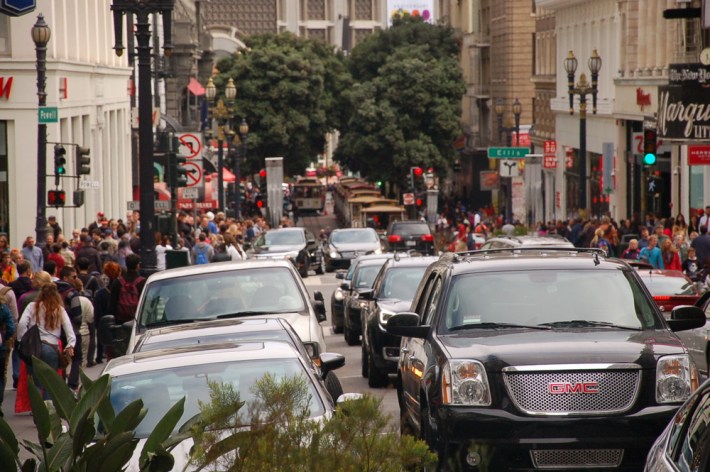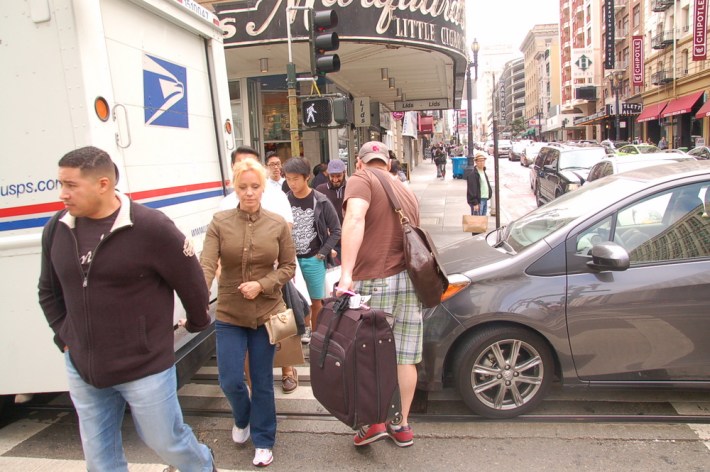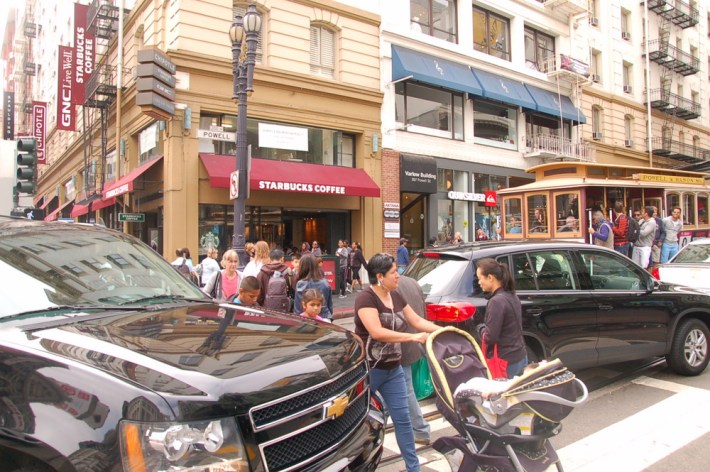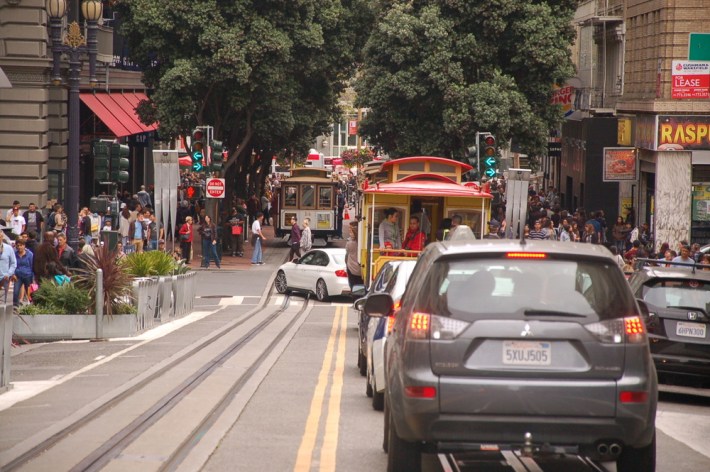Auto-Clogged Powell Street Could Be a Car-Free Haven
6:27 PM PDT on September 19, 2014
It's a wonder that anyone drives a car on Powell Street in Union Square. Yet along the busiest pedestrian thoroughfare this side of the United States, you'll typically see the perplexing scene of drivers, sitting in a line heading down the hill, all seemingly going nowhere in particular and certainly not very quickly. These private autos block bustling crosswalks, jam up Muni's world-famous cable cars and its busiest bus line, and make an overall shameful display out of what many see as San Francisco's gateway.
Allowing cars on the two-block stretch of Powell, between Ellis and Geary Streets, has made even less sense ever since all street parking, except for loading zones, was removed in 2011 for the Powell Street Promenade, a "mega parklet" that extended Powell's sidewalks using temporary materials.
Powell doesn't connect drivers to Market Street either, since the southernmost block was turned into a plaza for people and cable cars only in 1973. The vast majority of drivers drive down the street only to turn off of it, squeezing through busy crosswalks and taking up a disproportionate amount of street space along the way.
"Powell deserves to be the best possible street that San Francisco can make it," said Andres Power, who managed the Powell Promenade project at the Planning Department and is now an aide for Supervisor Scott Wiener. "It's in many ways an entry point to the city. Pretty much every single person who visits San Francisco walks along those blocks at some point."
Power said the promenade project was "seen as an initial first step to start a longer conversation about what Powell Street should be," and that ideas like extending the pedestrianized zone and adding car restrictions have long been discussed. The promenade project itself required extensive coordination with merchants and property owners, notably to move deliveries from Powell to side streets.
Karin Flood, president of the Union Square Business Improvement District, said the organization doesn't have a position yet on further car restrictions. She said the organization is open to studying the idea, although maintaining car access to hotels and parking garages is a concern. "There still are people that prefer to drive, and need to drive, for whatever reason," she said. "A lot of our luxury retailers are really wedded to their clients that do come in by car."
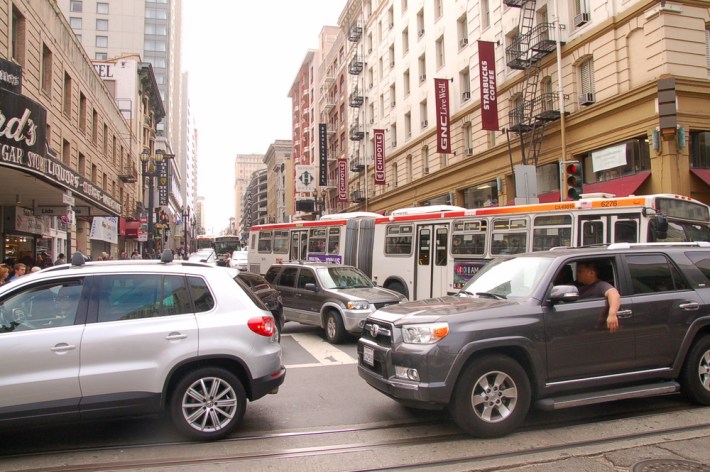
Powell, through the Union Square area, is packed with upwards of 100,000 pedestrians on an average weekend. A study conducted by the transportation design firm Fehr and Peers showed that 85 percent of all trips that pass through the intersection of Powell and Ellis are on foot.
Peter Tannen, a retired SFMTA traffic engineer who oversaw the Valencia Street road diet, said the idea of restricting cars on Powell "looks good to me, just based upon the times I've been on Powell Street."
SFMTA officials said they currently aren't looking seriously at car restrictions on Powell, but that they could in the future, once the Central Subway is completed.
The SFMTA is currently planning car restrictions on and around Market Street to divert private autos off of that thoroughfare, starting early next year. Tim Papandreou, the SFMTA's director for strategic planning and policy, said the agency will look at diversions on "natural spurs off of Market Street," but couldn't name any specific plans yet.
But the SFMTA has stalled on trying out short-term ideas like traffic diversions or a pedestrian plaza on Ellis, between Powell and Market, citing traffic complications created by subway construction through the area.
"The Central Subway is moving things around every couple weeks," said Jerry Robbins, the SFMTA's interim director of the Sustainable Streets Division until Tom Maguire takes over on October 14. Maguire will come from New York City's Department of Transportation, which pedestrianized much of Times Square.
Robbins said he thinks "it's a little premature to propose any particular solutions at this point," but that they "should be looked at" once subway construction detours have ended.
Stockton, south of Geary, is closed to motor traffic until 2016, and has been since 2012. Robbins confirmed that many of the drivers heading southbound on Powell may just be lost, as many who exit the Stockton Tunnel "just seem to ignore" signs detouring them onto Sutter or Post Streets. Instead, many drivers continue straight until they're forced to turn right on to Geary, and many then turn left on Powell. Because of this pattern, Robbins said Powell has been especially congested with cars in the last couple of years. To mitigate the problem, he said the SFMTA installed protected turn signal phases to let more cars through the crowds of pedestrians crossing at Powell and Ellis, near the cable car turnaround.
On an average day on Powell, cable car operators can be seen haplessly stuck behind aimless drivers trying to edge through crosswalks, a stop-and-go pattern that wears significantly on the cables. If Powell undergoes a major redesign, it's expected to happen in conjunction with a cable overhaul that was originally expected this year.
Flood, of the Union Square BID, said she sees how the concept could work. "I just returned from Europe, and they have walking streets everywhere," she said. "I know that other cities have large pedestrian-only areas, so I know that works well."
Read More:
Stay in touch
Sign up for our free newsletter
More from Streetsblog San Francisco
Streetsblog SF editor Roger Rudick offers constructive criticism of Chicago’s downtown bike network
"There were blocks that felt very safe and very secure," he said. "But then you're immediately – voom! – disgorged into three lanes of moving traffic with no protection."
Commentary: There is Zero Ambiguity to the West Portal Tragedy
What happened in West Portal was entirely predictable and preventable. The city must now close Ulloa to through traffic and make sure it can never happen again
